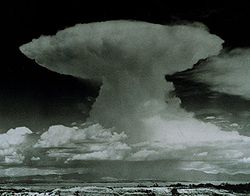- Cumulonimbus cloud
-
Cumulonimbus cloud 
Cumulonimbus incusAbbreviation Cb Symbol 
Genus Cumulonimbus (heap, cloud/severe rain) Altitude 2,000–16,000 m
(6,500–60,000 ft)Classification Family D (Vertically developed) Appearance Very tall and large clouds Precipitation cloud? Yes, often intense, but may be virga (virga—occasionally a streak of precipitation but evaporates before it hits the ground) Cumulonimbus (Cb) is a towering vertical cloud (family D2) that is very tall, dense, and involved in thunderstorms and other inclement weather. Cumulonimbus originates from Latin: Cumulus "accumulated" and nimbus "rain". It is a result of atmospheric instability. These clouds can form alone, in clusters, or along a cold front in a squall line. They create lightning through the heart of the cloud. Cumulonimbus clouds form from cumulus clouds (namely from cumulus congestus) and can further develop into a supercell, a severe thunderstorm with special features.
Contents
Appearance
 Exceptionally clearly developed single-cell Cumulonimbus incus displaying the classic anvil shape; gusts will happen near and under it.
Exceptionally clearly developed single-cell Cumulonimbus incus displaying the classic anvil shape; gusts will happen near and under it.
The anvil is the flat layer at the top. The downdraft is the rainy area to the right. Cumulonimbus clouds usually form from cumulus coop at a much lower height, thus making them, like cumulus clouds, grow vertically instead of horizontally, thus giving the cumulonimbus its mushroom shape. The base of a cumulonimbus can be several miles across, and it can be tall enough to occupy middle as well as low altitudes; though formed at an altitude of about 500 to 13,000 feet (150 to 3,960 metres), its peak can reach up to 75,000 feet (23,000 metres)[1] in extreme cases. Typically, it peaks at a much lower height, usually up to 20,000 feet (6,090 meters).[verification needed] Well-developed cumulonimbus clouds are also characterized by a flat, anvil-like top (anvil dome), caused by straight line winds at the higher altitudes which shear off the top of the cloud, as well as by an inversion over the thunderstorm caused by rising temperatures above the tropopause. This anvil shape can precede the main cloud structure for many miles, causing anvil lightning. This is the largest of clouds usually extending through all three cloud regions when vertically developed. All other clouds are dwarfed even compared to small cumulonimbus clouds.
Species
- Cumulonimbus arcus
- Cumulonimbus calvus: cloud with puffy top, similar to cumulus congestus, but larger;
- Cumulonimbus capillatus: cloud with cirrus-like, fibrous-edged top;
- Cumulonimbus incus: subtype of Cumulonimbus capillatus, with flat anvil-like top.
- Cumulonimbus mammatus
- Cumulonimbus pannus
- Cumulonimbus pileus
- Cumulonimbus praecipitatio
- Cumulonimbus tuba
- Cumulonimbus velum
- Cumulonimbus virga
Effects
See also: Severe weather and ThunderstormCumulonimbus storm cells can produce heavy rain of a convective nature and flash flooding, as well as straight-line winds. Most storm cells die after about 20 minutes, when the precipitation causes more downdraft than updraft, causing the energy to dissipate. If there is enough solar energy in the atmosphere, however (on a hot summer's day, for example), the moisture from one storm cell can evaporate rapidly—resulting in a new cell forming just a few miles from the former one. This can cause thunderstorms to last for several hours. This multicell cloud structure exists until a cold downdraft preceding the cumulonimbus at ground level flows before the cloud at a distance sufficient to disrupt updraft (5–10 kilometers). From this moment on the cumulonimbus cloud quickly degrades and dissipates, forming cirrus spissatus, dense anvil-like cirrus, stratocumulus diurnalis or stratocumulus vesperalis. Cumulonimbus clouds can cause tornadoes.
Cumulonimbus clouds sometimes form mammatus clouds.
Cumulonimbus clouds contain severe convection currents, with very high, unpredictable winds, particularly in the vertical plane (updrafts and downdrafts). They are therefore extremely dangerous to aircraft. Smaller, propeller-driven planes cannot cope with the conditions and must fly around them; larger jet aircraft fly over the smaller ones and around larger examples. Larger planes are also equipped with weather radar and wind shear detectors to help guide them through, in the event that they need to pass through such clouds to land. Snow and ice conditions can develop in the colder upper portions of the clouds, even when the air temperatures at ground level are moderate.
The air convection can also form mesocyclones, which can cause hail and tornadoes.
Cloud types
Main article: List of cloud typesClouds form when the dewpoint of water is reached in the presence of condensation nuclei in the troposphere. The atmosphere is a dynamic system, and the local conditions of turbulence, uplift and other parameters give rise to many types of clouds. Various types of clouds occur frequently enough to have been categorized. Furthermore, some atmospheric processes can make the clouds organize in distinct patterns such as "wave clouds" or "actinoform clouds", these are large-scale structures and not always readily identifiable from single point of view.
Gallery
-
Cumulonimbus cloud over White Canyon in Utah
-

Cumulonimbus Cloud Formation Over Florida
See also
- Cumulonimbus calvus
- Cumulonimbus incus
- Cumulus congestus cloud
- Funnel cloud
- Hot tower
- Mammatus cloud
- Pileus
- Pyrocumulonimbus
- Squall line
- Storm
- Supercell
- Tornado
References
- ^ HABY, JEFF. "FACTORS INFLUENCING THUNDERSTORM HEIGHT". theweatherprediction.com. http://www.theweatherprediction.com/habyhints2/536/. Retrieved 17 June 2011.
External links
- Clouds-Online.com Cloud Atlas with many photos and description of the different cloud genus
- Cumulonimbus cloud at BBC Weather
- Weather Pictures and Storm Chasing – Cumulonimbus clouds
Cloud genuses Extreme-level High-level Medium-level Low-level Fog · Stratus (St) · Cumulus (Cu) · Stratocumulus (Sc) · Arcus (Roll) · Fractus · Funnel · Nimbostratus (Ns) · Shelf · Wall · Actinoform cloud · Undulatus asperatusVertical Cumulonimbus (Cb) · Cumulonimbus mammatus · Pyrocumulus · Pyrocumulonimbus · Overshooting top · AccessoryCategories:- Cloud types
- Severe weather and convection
Wikimedia Foundation. 2010.



